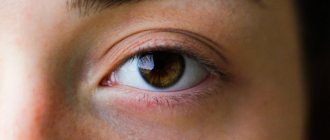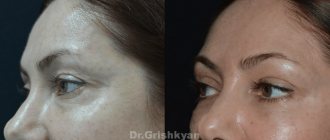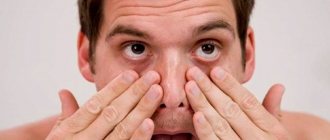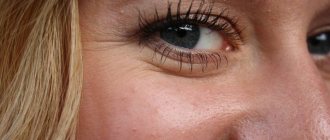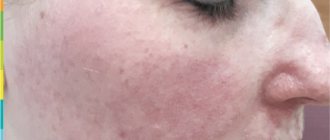Darkening of the eye area is often a consequence of lack of sleep. But what is the reason if the darkening does not disappear even after a long sleep? The fact is that good sleep is only one of the factors that influence the darkening of the eyelids and skin around the eyes. And although dark eyelids are not dangerous, they can negatively affect the mood and self-esteem of their owner.
In order to choose the most appropriate care, it is necessary to know more about each individual case, as there are a number of possible causes. We will consider the most common cases of darkening of the eyelids in this article.
Pregnancy
During pregnancy, some women begin to experience skin changes. Melasma[1] is one of the most common effects of pregnancy on the skin. It appears as brown or gray-brown pigmentation on the face, which may appear on the eyelids.
The appearance of these spots is associated with increased levels of melanin, the pigment responsible for skin color. In those places where cells begin to produce excess amounts of melanin, pigment spots form.
Some doctors believe that the appearance of melasma during pregnancy is due to changes in hormonal levels, but the exact cause remains unknown today.
How to treat?
If such a problem is hereditary, then it simply needs to be masked with a cosmetic product.
If the eyelid has darkened due to a genetic predisposition, then foundation or glasses can help hide such changes. Doctors also recommend doing a light eyelid massage or cold compresses. Dark eyelids or hyperpigmentation, which appears due to an unhealthy lifestyle, can be easily treated by restoring proper rest, sleep and diet. In addition, giving up alcohol and smoking has a positive effect.
Treatment of diseases takes place under the close supervision of a doctor. Argyrosis resolves quickly with the use of potassium iodide. For ochronosis, doctors prescribe vitamin C and medications that reduce alkaptonuria. People suffering from hemochromatosis take medications that contain iron and also follow a strict diet to increase the amount of iron in the body.
Dermal melanocytosis
Melanocytes are skin cells that produce melanin. In healthy skin, only melanocytes of the epidermis and hair follicles are able to synthesize melanin. However, with dermal melanocytosis, immature melanocytes (lingering in the dermis during embryogenesis) already begin to actively synthesize melanin, which leads to the formation of spots. If the dark eyelids have a similar origin, this can be easily determined by the gray or bluish-gray tint around the eyes[3].
Dermal melanocytosis can be either acquired or hereditary. The reasons for its occurrence may be:
- influence of the sun
- hormonal changes during pregnancy
- chronic eczema
Symptoms of blepharitis
The most common symptoms of blepharitis are redness of the edges of the eyelids and the eye itself, itching of varying severity, burning, lacrimation, foreign body sensation, and increased eye fatigue. With a long course, the disease provokes ulceration of the edges of the eyelids, changes in the shape of the eyelids, loss of eyelashes and the wrong direction of their growth, inflammation of the cornea. All this can lead to significant and irreversible vision loss. That is why it is necessary to consult an ophthalmologist in time, because timely prescribed treatment will ensure a quick recovery. Otherwise, the process will become chronic, and treatment will take months or even years.
Disease prevention
The best preventative measure to prevent meibomitis is clean eyelids. In other words, maintaining and regular hygiene of the visual organs sharply reduces the likelihood of inflammation of the sebaceous glands. Of course, touching your eyes with dirty hands (for example, to remove a speck of dirt or for self-massage when your eyes are tired) is completely unacceptable - this is fraught not only with meibomitis, but also with a number of serious diseases. In hazardous industries and in unfavorable climates, it is imperative to use personal eye protection.
It is also necessary to avoid hypothermia and, conversely, overheating, monitor the general condition of the visual organs (for example, if necessary, take measures to artificially moisturize the cornea, undergo a course of vitamin therapy and/or immunostimulation). If there is such a possibility, it is advisable from time to time to perform a special massage in the nearest ophthalmology office (not independently) to evacuate excess secretion of the meibomian glands.
Why do dark circles appear under the eyes?
Services Doctors Results Reviews
Expert tested
Natalya Borisovna Zhmurina Director, Chief Physician of “A Clinic” Dermatovenereologist, cosmetologist
Publication date: August 07, 2022
Review date: November 08, 2022
In the 20s of the last century, there was a fashion for dark circles under the eyes. It was believed that people with gray or purple skin under their eyes were passionate and romantic. At the same time, the effect of a “dramatic look” was achieved with the help of special makeup - shading the line of eyeliner and applying eye shadow.
But fashion, as we know, is fickle, and today dark circles under the eyes are no longer an ideal of beauty. No one in everyday life deliberately applies “war paint” to their face. And if dark circles appear under the eyes, then there are reasons for this that should not be ignored. What are they?
First of all, let us remind you that the area around the eyes is very delicate and requires maximum attention and care. The skin here is 5 times thinner than the skin in the cheek or chin area. In addition, in the periorbital area there are practically no sebaceous glands, subcutaneous fat is poorly developed, and there are few collagen and elastin fibers. All this leads to dry skin, rapid loss of tone and early aging. An additional risk factor is the significant facial load to which the periorbital region is exposed - a person blinks from 40 to 100 thousand times per day. The vascular network in this area is located superficially and often shines through thin, stretched skin, creating the effect of dark circles under the eyes.
A common cause of dark circles under the eyes is overwork and chronic lack of sleep.
. It is known that the normal sleep duration of an adult should be approximately 7 – 8 hours. If a person does not get enough sleep, then, in addition to general exhaustion of the body, the eye muscles become overstrained, their energy reserves are depleted, as a result of which their need for various substances, especially oxygen, increases. In order to compensate for the lack of necessary substances, hyperperfusion occurs, that is, an increase in blood flow. This, in turn, leads to the fact that the skin around the eyes acquires a dark shade due to the overflow of blood vessels. In addition, with lack of sleep, the skin of the face becomes paler, which makes the circles under the eyes more pronounced.
Professional activity
, associated with working at a computer for a long time, also leads to overwork and the appearance of dark circles. People who constantly look at the monitor screen overstrain their visual analyzers. In this case, micro-tears occur in the eye capillaries and a vascular mesh forms under the eyes. The circles have a bluish tint due to blood accumulated under the skin.
Some people have dark circles under the eyes - a congenital factor or a hereditary predisposition
.
Periorbital hyperpigmentation (hyperpigmentation of the skin of the eyelids) is the name of this condition. Pigmentation can affect only the infraorbital region or the entire periorbital zone. This condition is usually not accompanied by other symptoms and is rarely associated with diseases of the body. Therefore, people experience, as a rule, only aesthetic discomfort. Periorbital hyperpigmentation can also appear in connection with age-related changes in the skin around the eyes
(impaired blood supply, thinning of the skin). Most often, increased pigmentation of the skin of the eyelids occurs in women over 30 years of age with dark skin color.
Effect of ultraviolet rays
also leads to hyperpigmentation of the skin in the eyelid area.
In some cases, hyperpigmentation occurs after inflammatory diseases of the skin of the eyelids
. This pigmentation can persist for a long time.
Poor nutrition also has an adverse effect on the condition of the skin.
. After all, the skin looks healthy only when the body as a whole receives the required amount of not only proteins, fats and carbohydrates, but also various microelements and vitamins. And when people are malnourished and go on strict diets, all body systems become unbalanced. Circles under the eyes can appear due to a lack of many microelements in the body. For example, insufficient intake of iron into the body is accompanied by the development of iron deficiency anemia. Zinc is involved in the metabolism of fats, which play a large role in the normal functioning of the immune system.
Vitamin K is involved in blood clotting. It is one of the main elements needed to combat dark circles under the eyes. Vitamin A ensures regeneration processes in the skin, slows down its aging, and reduces age-related pigmentation.
Vitamin C ensures the functionality of the body's defenses and strengthens the vascular wall. With a deficiency of this vitamin, capillary walls become fragile, resulting in micro-tears, which is accompanied by the appearance of dark circles under the eyes. Vitamin E slows down skin aging, is an antioxidant, and fights free radicals that destroy the normal structure of the skin.
With anemia, a pathological condition associated with a decrease in the concentration of hemoglobin in the blood, circles under the eyes are permanent and do not disappear even after proper rest. When the level of hemoglobin decreases, its main function - transporting oxygen to the tissues - is disrupted and their oxygen starvation develops.
There is constant increased fatigue, decreased performance, frequent dizziness, and shortness of breath. With anemia, the skin becomes pale, the eyes become sunken, and dark circles form under the eyes.
Stress and depression
They also don’t make a person more beautiful. When a person is constantly exposed to stress, the body becomes exhausted. Under-eye circles after stress usually appear within a few days and may appear bluish or brown. Their appearance may be a sign of an individual reaction to a stressful situation.
During stressful situations, jumps in blood pressure may occur, which is accompanied by the appearance of circles under the eyes and headaches.
Circles under the eyes can also appear due to the incorrect selection of skin care cosmetics
, which is not at all suitable for a person’s skin type. The quality of the cosmetics used is also of great importance. Excessive use of decorative cosmetics can also lead to the appearance of circles under the eyes, especially if they are of poor quality. The fact is that such cosmetics often help close skin pores. The skin stops receiving oxygen and its color changes.
Under-eye circles can appear due to various eye diseases
, predominantly of an inflammatory nature (conjunctivitis, blepharitis). With the development of the inflammatory process, swelling of the skin of the eyelids and circles under the eyes are usually observed. In addition, inflammatory eye diseases are characterized by lacrimation, redness of the eyes, and itching.
Any circulatory disorders
, especially chronic ones, may be accompanied by the appearance of dark circles under the eyes. The reason for this phenomenon is the anatomical features of the periorbital region, in which venous stagnation occurs in the event of circulatory disorders in the body.
One of the most common diseases characterized by circulatory disorders is vegetative-vascular dystonia. This condition can develop at any age. As a rule, it is a consequence of constant stressful situations, chronic fatigue, diseases of the nervous system and other factors.
In addition to the above reasons, dark circles under the eyes are a consequence of kidney disease, liver disease, allergies and diabetes and require serious medical treatment.


